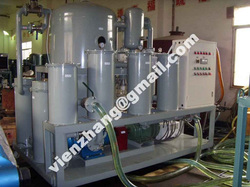 To improve transformer oil, insulating oil dielectric strength, making less trace moisture content, gas content, dielectric loss factor and other indicators, before pumping transformer oil into the tank must be preceded by a rigorous treatment, the effective removal of oil in the water, gas and impurities. In practice applications, we have for different types of transformer oil, insulating oil using different forms of oil filter for targeted treatment, results were better.
1. For the general transformer are impurities, water and dust contaminated transformer oil, you can use the JL pressure transformer oil filter, through a series loop filter, is usually able to meet the requirements. Its principle is to use oil filtering paper to absorb moisture, filter impurities. Advantage is a subtle effect of impurity removal is good, its simple structure, convenient maintenance, reliable operation, easy handling, so widely used. The disadvantage is that water filters are not thorough; it only applies to low-voltage level of transformer oil, insulating oil filtration.
2. Now generally used a vacuum oil purifier (there are ZY single stage vacuum transformer oil purifier machine ZYD double stages vacuum transformer oil purifier), it can not only completely remove the oil water and gas, but also can effectively remove small impurities. The process is: when dealing with coarse filtration of transformer oil → → → heating oil fine filtration vacuum degassing → Absolute dehydration. Coarse metal mesh filter and strong magnets, fine filtration is usually 1 ~ μm micro-filter impurities. At present many different types of fine filters, sintered metal powder material, metal microporous materials, ceramic filter media and the use of special structure of filter paper filter core and so on.
Transformer oil heating degassing vacuum dehydration. The principle is that the vacuum inside the tank, the heating of transformer oil with the formation of oil mist spray approach, leaving the oil in the gas and water escape. Oil temperature around 60 ℃ in general, not too high so as to prevent aging of transformer oil. This approach dehydration degassing effect is better, is more commonly used methods.
If the oil is sprayed into the oil has a certain diameter beads, the beads due to higher oil interfacial tension, making the oil water and gas within the beads difficult to bring into full play. To this end, the diameter of injection holes to choose appropriate, and generally taking the time to be in the tank set up with a few baffles the mouth to prevent the transformer oil is pumped vacuum.
At present, foreign and domestic has also adopted a more advanced membrane dehydration degassing method is to make the oil into the tank, through a degassing components formed after the thin oil film, and has always been to film the entire process of degassing state of complete dehydration , thus making the water in oil and gas easier to remove.
3. Badly contaminated transformer oil filter/oil regeneration (Choose our BZ oil regeneration device).Contaminated transformer oil (commonly known as dirty oil), is being mixed with very small impurities and oil molecules combine to form a colloidal contaminated transformer oil, and after years of used transformer oil, the general product release for the repairing of oil (This oil has a very low pH value). Of such waste oil must be used in order to improve the absorption approach to oil targets. Were more commonly used silica (SiO2) or activated alumina (A12O3) as adsorbent. Waste oil processing system in order to ensure full access to silicone and transformer oil, and to facilitate replacement of silica gel, silica gel tank set up in a number of partitions, the silica gel into a small cloth bag within the rotation, not in bulk. After the heating of the transformer oil into the gel tank, do a certain time cycle to its full absorption effect, and then injected into the Absolute through the oil filter tank. In the process should be regularly monitored to determine the absorption effect, when the absorption effect is not apparent that it should consider replacing the silica gel. General silicone oil consumption by weight or about 3% ~ 5%. Waste oil processing system with the new oil-processing systems should be separated to avoid cross-contamination. Loading used waste oil cans, containers, etc. must be thoroughly cleaned before be used for the normal production of the oil system.
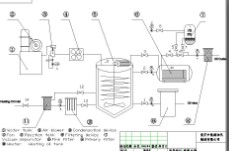 Dehydration(Degas)system
The Double-horizontal vacuum evaporation vessels can enlarge evaporation area efficiently. The heater, being places in the vacuum vessels, becomes an evaporator. Thus the evaporation areas of Double-horizontal vacuum vessels are three times more than of the common vacuum vessel. This innovation can dehydrate and degas effectively and separately. This optimal structure of the dehydration (degas) system enlarge the surface area of oil exposed to the vacuum system and extends the flowing distance of the oil in the vacuum system. Thus there has sufficient time to remove the moisture and gas from the oil by vaporization.
Filtering system
The filtering materials with variable apertures are made of specialized glass fiber.the sizaes of the filtering fiber and aperture dwindle gradually in the different filtering stages. The impurities with different particulate sizes are filtered step by step.the capability of removing particulate matters is improved greatly by this method.
The filtering system has stable and perfect filter fineness. The filter fineness has several grades. Including 1.2.3.4.5.6.10. μm etc.
The filtering system is equipped with reverse rinse and filth device.it improves the effectiveness filtering and extends the lifetime of filter awfully
Electrical apparatus controlling system
The main components of the electrical apparatus made by Siemens, Schneider company ensure the safety of the controlling system .having interlocked protective system, pressure protective device which will avoid overload,over voltage,blank pumping,blank heating,oil leak and electricity leak etc.
Oil heating system
The unique effective electric heater structure heats the oil uniformly
Oil heater system assures less than 1.0w/cm2.during the heating process, the deterioration of the oil cuased by overheating is avoided.
The oil temperature can be adjusted between 0℃ to 100℃.the heater is controlled manually or automatically .the heater will stop automatically when the oil temperature reaches a certain degree
Being installed with safety protection devices, the heating system is secure and reliable.the heater will stop operation automatically when the oil volume of inlet is too much to avoid the damages of the heater
Oil-level controlling system
The oil-level floating ball and double-infrared liquid level automatic controller system are installed in the vacuum vessel to control the oil level so as to avoid the oil leaking in the operation.
The new innovation of eliminating forth can avoid the oil ejecting and gushing during the process.
High quality components
The main component parts of our products such as vavuum pump ,oil pump, motor and electric apparatus are from SIEMENS, ABB, SCHNEIDER, LEYBOLD and AMICO etc. They ensure our products high quality and reliability.
Structure and apparatus of oil purifier
Our products adopt ship-shape chasis-mount structure to ensure oil leak proof and protect the environment from pollution.
The whole equipment is characterized by small size.light weight and convenient to move around.various sizes and configurations (alloy shield) available
Vailable in mobile or stationary options
Automatic vacuum oil purifier or anti-explosion vacuum oil purifier is both available according to customers' need.
Cooler, medium condenser system
The system is composed of cooler .condenser,water receiver etc.
The vapor and other gas ,which is evaporated from vacuum separator, first drop in temperature and are rid of moisture in condenser, then are condensed again in cooler which has retarded exchange media .the reductive condensed water are discharged by water receiver,the dry gas ,which are condensed and rid of moisture twice,are discharged to air by vacuum pump so that it protects vacuum pump.
The plant is characterized by small size,light weight,rich color, and our company can produce trail car type and closed type (alloy shield) according to the customer's requirement.
In order to make sure that the stable of oil purifier plant which can work long time and extend the life of the machine, the oil purifier's main parts such as electric control parts, electric motor, vacuum pump,oil pump are imported from SIEMENS,LEYBOLD,ABB etc.
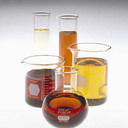 People love “do’s and don’ts” lists. A quick Google search will yield 10.9 million hits for what to do and not do. A quick scan through the endless supply of D&D lists will show that many of the subjects people feel the need on which to provide unsolicited consulting really don’t have a defined method of approach beyond common sense. For example, the do’s and don’ts of air travel barely stretch outside the realm of common sense. Advice such as “Do not place your firearm in your carry-on luggage” or “Do not smoke while in the aircraft” goes without saying. Then there are the do and do-not-do lists for topics that are highly subjective such as fashion (Don’t wear white after Labor Day). Thankfully, in the realm of oil analysis and machinery lubrication, few do’s and don’ts can be considered subjective. In this case, we’re talking about what to do and not do related to oil sampling for analysis. These simple rules will make or break the integrity of your sample, which is meant to drive your maintenance and reliability decisions. Oil analysis is a condition monitoring tool designed to monitor: - fluid properties, or the condition of the oil and the additives;
- fluid contamination; and,
- machine wear.
However, the analysis of a sample greatly depends on the quality of the sample itself. A high-quality sample translates into one that is rich with data and free from noise. The content of this article is nothing new. Dozens (if not hundreds) of articles, papers and books have had some advice for us to follow when extracting a sample of oil from a machine for analysis. However, as an industry, we don’t seem to get it right. The same rules for oil sampling still apply, just like they always did. Here is the most recent do and do-not-do list for oil sampling from my perspective. 1) DO sample from running machines. DO NOT sample “cold” systems. This rule goes beyond simply starting the machine to take the sample. The ideology behind oil analysis is to capture a “snapshot” of the system at the time of sampling. The timing of the sampling should be when the system is under the greatest amount of stress. Typically, the best time to sample a system is when the system is under normal working load and normal conditions. This can be a tricky task when sampling from a system that continuously cycles during normal production, such as the hydraulic system on an injection molding machine. It’s under these conditions that we’ll capture a sample that best represents the machine conditions most likely to cause accelerated wear. 2) DO sample upstream of filters and downstream of machine components. Filters are designed to pull out wear debris and contaminants, so sampling downstream of these data-strippers provides no value. However, taking a sample before and after a filter for a simple particle count will allow you to see how well the filter is currently operating. Obviously, we expect the particle count before the filter to be higher than after the filter. If it’s not, it’s time to change the filter. Condition-based filter changes can be very important for sensitive systems and expensive filters. 3) DO create specific written procedures for each system sampled. DO NOT change sampling methods or locations. Everything we do in oil analysis and machinery lubrication should have a detailed procedure to back up the task. Each maintenance point in the plant should have specific and unique procedures detailing who, what, where, when and how. Oil sampling procedures are no different. We need to identify the sample location, the amount of flush volume, the frequency of sampling, the timing within a cycle to sample, and indicate what tools and accessories to use on that specific sample point based on lubricant type, pressure and amount of fluid required. 4) DO ensure that sampling valves and sampling devices are thoroughly flushed prior to taking the sample. DO NOT use dirty sampling equipment or reuse sample tubing. Cross-contamination has always been a problem in oil sampling. The truth of the matter is that flushing is an important task that is often overlooked. Failure to flush the sample location properly will produce a sample with a high degree of noise. Flushing prior to sampling needs to account for the amount of dead space between the sample valve and the active system multiplied by a factor of 10. If there is a run of pipe 12 inches long between the sample valve and the active system that holds one fluid ounce of oil, you need to flush a minimum of 10 fluid ounces before taking the sample for analysis. Flushing the dead space also will flush your other accessories such as your sample valve adapter and new tubing. 5) DO ensure that samples are taken at proper frequencies. DO NOT sample “as time permits.” Many of those responsible for taking oil samples rarely see the results of the analysis. One of the most powerful aspects of oil analysis is identifying a change in the baseline of a sample and understanding the rate at which the change has occurred. For example, a sample of new oil should have zero parts per million (ppm) of iron when tested as the baseline. As regular sampling and analysis continues, we may see the iron level increase. An increase of 10 or 12 ppm per sample may be considered critical; however, if the frequency is not consistent, what is considered normal becomes very subjective. If our frequency of sampling is 12 months, a rise in iron of 12 ppm isn’t a major cause of concern. If our frequency is weekly, a rise in iron of 12 ppm is very concerning. Setting up the appropriate sampling frequency and adhering to it will allow for precise analysis and sound maintenance decisions. 6) DO forward samples immediately to the oil analysis lab after sampling. DO NOT wait more than 24 hours to send samples out. As mentioned earlier, oil sampling is much like taking a snapshot of your system at a point in time. The health of a lubricated system can change dramatically in a very short period of time. If a problem is detected in a system, the earlier it is detected, the less catastrophic potential it may have. Jumping on a problem early will not only allow you time to plan for a repair, but the repair will potentially be less significant.
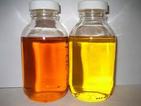 Transformer oil or insulating oil is usually a highly- refined mineral oil that is stable at high temperatures and has excellent electrical insulating properties. It is used in oil-filled transformers, some types of high voltage capacitors, fluorescent lamp ballasts, and some types of high voltage switches and circuit breakers. Its functions are to insulate, suppress corona and arcing, and to serve as a coolant. The oil helps cool the transformer. Because it also provides part of the electrical insulation between internal live parts, transformer oil must remain stable at high temperatures for an extended period. To improve cooling of large power transformers, the oil-filled tank may have external radiators through which the oil circulates by natural convection. Very large or high-power transformers (with capacities of thousands of KVA) may also have cooling fans, oil pumps, and even oil-to-water heat exchangers. Large, high voltage transformers undergo prolonged drying processes, using electrical self-heating, the application of a vacuum, or both to ensure that the transformer is completely free of water vapor before the cooling oil is introduced. This helps prevent corona formation and subsequent electrical breakdown under load. Oil filled transformers with a conservator (an oil tank above the transformer) tend to be equipped with Buchholz relays. These are safety devices that detect the build up of gases (such as acetylene) inside the transformer (a side effect of corona or an electric arc in the windings) and switch off the transformer. Transformers without conservators are usually equipped with sudden pressure relays, which perform a similar function as the Buchholz relay. The flash point (min) and pour point (max) are 140 °C and −6 °C respectively. The dielectric strength of new untreated oil is 12 MV/m (RMS) and after treatment it should be >24 MV/m (RMS). by wikipedia
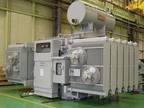 Vacuum transformer oil filter is mainly used for removing trace water, gas and impurities from insulating oil, improving the insulating oil performance index. It is mainly applied to purification of 110KV, 220KV, 500KV, 750KV, 1000KV power transmission equipment insulating oil, also applied to treat low viscosity oils, like insulating oil, turbine oil, and hydraulic oil in the transmission equipment which is lower than 110KV. Meanwhile, Series ZYD oil purifier can be used as independent vacuum source with functions of vacuum drying and vacuum oiling. Insulating oil performance mainly decided by oil’s water content, If the water is not saturation in the oil, it appears as the molecular states; If the water is saturation in the oil, it appears as the liquid states and stay at the bottom of container. Under the vacuum states, because the less gas content, the water and gas in the oil will be escaped from the oil and evacuated by the vacuum pump. The higher vacuum value (Close to 0 Pa), the higher speed of water molecular volatilization (The latest technology, the Vacuum oil purifier can reach to 1Pa Working vacuum value). The gas and water which dissolved in the oil will become gaseity and exhausted by vacuum pump. The oil temperature affect vacuum oil purifier working efficiency, the higher temperature, the water molecular get more kinetic energy, so it is higher diffused speed of water molecular. But, exorbitant temperature will cause fracture of carbon chain for oil molecular, if that will make oil bad. So we don’t suggest the oil temperature excess 80℃. Also the impurity will affect oil dielectric strength, so the vacuum oil purifier requires high filtration precision. See more the products details
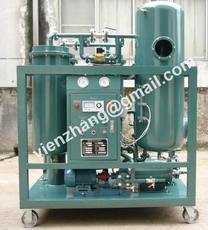 turbine oil dehydration Gone are those times when it was quite expensive to maintain lubricating or hydraulic oils. The only technique obtainable was to change for better the fluid on frequent intervals. The scenario has changed since then. Currently, stress is being offered on maintaining the oil clean whenever possible. The main reason of malfunction in moisturized and gas machines is the existence of pollutants in fluids.
The system breakdown may result in earnings loss, substantial servicing costs and worst being the buyer loosing assurance in the particular machine or manufacturer. To make certain steady operating of your models, it is significant to check and retain turbine oil.
Setting up a proper turbine oil purification method can only satisfy the requirements. There are many gas component companies coming up with total lubrication oil systems for gearboxes of wind turbines. These devices include filters, pumping systems, valves coolers, heaters and piping method for connecting these parts. The benefit of having such system is that the devices are examined thoroughly and offered with assurance of reliability from qualified vendors only. Another growing filtering technique is gaining interest these days. It is offered by including features and pieces in a manifold block instead of piping each and every part individually. The advantage of preserving such a method is to limit seepage possibility, lower assemblage time thus offering a far more stream-lined and lighter and reliable system.
The vacuum distillation process is considered highly effective with proven achievement rate. This procedure assists in cleansing the turbine oil by removing emulsified and dissolved water in addition to fine particulate and unwanted gas. The main benefit of setting up such a system is because they are all-in-one and skid mounted, may be handled instantly or with a control panel. Some of these products ensure processing of almost 100% of the reservoir capacity per hour. The usage of Coalescer / Separator and substantial quality filter systems might help clean the liquid of water and chemical contamination. This method makes certain very high quality of oil cleanness.
While installing the lubricating oil purifier, you should measure the active system and the degree of filtering required to preserve its performance. There isn’t any point deciding on high cost purification models in case your necessity is minimal. On the other hand, try not to bargain on high quality while buying the cleanser. You can pick a portable technique too, if the circumstance so demands..
你可以通过发表一篇新的内容来开始创作博客。你可以通过点击评论下方来进行编辑或删除本提示。你也可以把各种元素从顶部工具栏拖动到侧栏,从而对侧栏进行自定义。
|







 RSS Feed
RSS Feed


